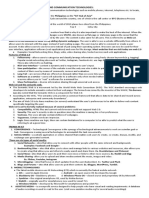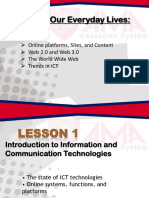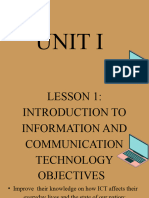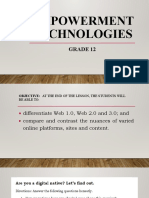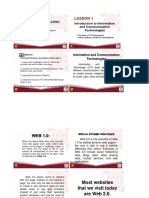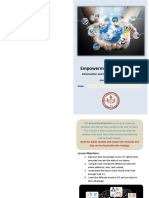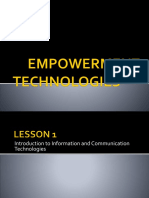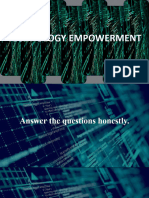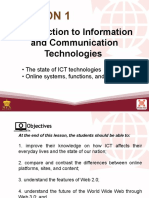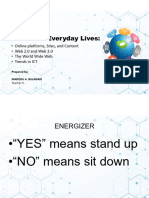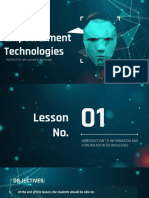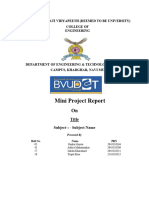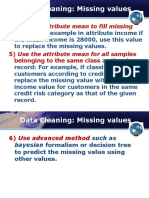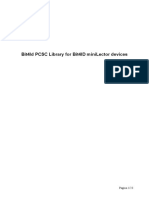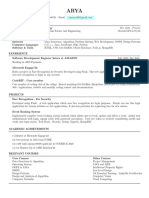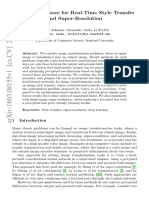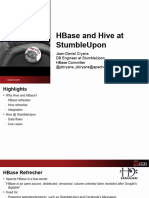Name:_____________________________
EMPOWEMENT TECHNOLOGIES
(Week 1-2)
\
�Features of Web 2.0
• Folksonomy - It allows users to categorize and classify/arrange information
using freely chosen keywords (e.g., tagging). Popular social networking sites
such as Twitter, Instagram, Facebook, etc. use tags that start with the pound
sign (#). This is also referred to as hashtag.
• Rich User Experience - Content is dynamic and is responsive to user’s input.
An example would be a website that shows local content. In the case of social
networking sites, when logged on, your account is used to modify what you
see in their website.
• User Participation - The owner of the website is not the only one who is able
�to put content. Others are able to place a content of their own by means of
comment, reviews, and evaluation. Some websites allow readers to comment
on an article, participate in a poll, or review a specific product (e.g.,
Amazon.com, online stores).
• Software as a Service - Users will subscribe to a software only when needed
rather than purchasing them. This is a cheaper option if you do not always
need to use a software. For instance, Google Docs is a free web-based
application that allows the user to create and edit word processing and
spreadsheet documents online. When you need a software, like a Word
Processor, you can purchase it for a one-time huge amount and install it in
your computer and it is yours forever. Software as a service allows you to
“rent” a software for a minimal fee.
• Mass Participation - It is a diverse information sharing through universal
web access. Since most users can use the Internet, Web 2.0’s content is based
on people from various cultures.
Web 3.0
• also called as Semantic Web
• Semantics – ability of Web technologies to understand and interpret human-
generated content
• The aim of Web 3.0 is to have machines understand the user’s preferences to
be able to deliver web content specifically targeting the user.
• The Internet is able to predict the best possible answers to your question by
“learning from your previous choices
Trends in ICT
As the world of ICT continues to grow, the industry has focused on several
innovations. These innovations cater to the needs of the people that benefit most out
�of ICT. Whether it is for business or personal use, these trends are current front
runners in the innovation of ICT.
1. Convergence
• Technological convergence is the combination of two or more
different entities of technologies to create a new single device.
• Example: Using of smartphone to create word documents that was
previously can only be created using desktop computer.
2. Social Media
• It is a website, application, or online channel that enables web users
to create, co-create, modify, and exchange user-generated content.
• Types of Social media:
1. Social Networks - sites that allow you to connect with other
people with same interests or background.
Examples: Facebook, Google+
2. Bookmarking Sites - sites that allow users you to store and
manage links to various websites and resources, and to tag
Examples: StumbleUpon, Pinterest or
3. Social News - sites that allow users to post their own news items links
Examples: reddit, dig to other news sources.
4. Media Sharing - sites that allow you to upload and share
media content like images, music, and video.
Examples: Flickr, YouTube, and Instagram
5. Microblogging - sites that focus on short updates from the
user. Those who are subscribed will receive updates.
Examples: Twitter Plurk
6. Blogs and Forums - sites that allow users to post their
content.
�Examples: Blogger, WordPress, Tumblr
�Answer the following questions:
1. Why do you think microblogging platforms have become popular when regular blogging
platforms already exists?
2. 2. What do you think of Web 3.0? Do you think it will be realized someday in the future?
Identification. Write SO if the social media website is a social network, BS for
bookmarking site, SN for social news, MS for media sharing, MI for
microblogging, and BF for blogs and forums.
1. Facebook
2. Blogger
3. Twitter
4. Reddit
5. WordPress
6. Google+
7. Instagram
8. Pinterest
9. YouTube
10. Flickr
